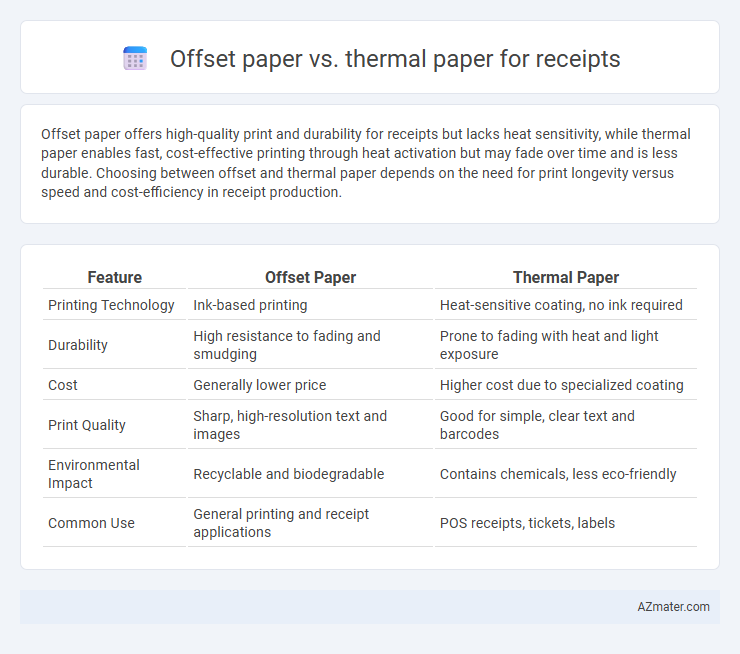Offset paper offers high-quality print and durability for receipts but lacks heat sensitivity, while thermal paper enables fast, cost-effective printing through heat activation but may fade over time and is less durable. Choosing between offset and thermal paper depends on the need for print longevity versus speed and cost-efficiency in receipt production.
Table of Comparison
| Feature | Offset Paper | Thermal Paper |
|---|---|---|
| Printing Technology | Ink-based printing | Heat-sensitive coating, no ink required |
| Durability | High resistance to fading and smudging | Prone to fading with heat and light exposure |
| Cost | Generally lower price | Higher cost due to specialized coating |
| Print Quality | Sharp, high-resolution text and images | Good for simple, clear text and barcodes |
| Environmental Impact | Recyclable and biodegradable | Contains chemicals, less eco-friendly |
| Common Use | General printing and receipt applications | POS receipts, tickets, labels |
Overview of Receipt Paper Types
Receipt paper types primarily include offset paper and thermal paper, each designed for specific printing technologies and uses. Offset paper is typically used with impact printers, offering durability and suitability for multi-part forms, while thermal paper is coated with a heat-sensitive layer that reacts instantly during thermal printing, enabling faster and quieter receipt production. Thermal paper is favored for point-of-sale applications due to its speed and cost-efficiency, though it may fade over time compared to the more durable offset paper.
What is Offset Paper?
Offset paper, commonly used in receipt printing, is a high-quality, uncoated paper designed for clear and sharp printing through traditional offset lithography. Unlike thermal paper, it requires ink to produce images, offering durability and resistance to heat and moisture. Offset paper provides long-lasting receipts with excellent print clarity, ideal for businesses needing archival-quality documentation.
What is Thermal Paper?
Thermal paper is a special heat-sensitive paper coated with a chemical that changes color when exposed to heat, eliminating the need for ink or toner in receipt printing. Its fast print speed, high durability, and cost-effectiveness make it the preferred choice for point-of-sale systems, kiosks, and ATMs. Unlike offset paper, thermal paper produces clear prints instantly but requires protection from heat, light, and oils to prevent fading.
Print Technology Differences
Offset paper uses traditional ink-based printing technology involving rollers and plates that transfer ink onto the paper surface, producing sharp and durable prints ideal for high-volume receipts. Thermal paper relies on heat-sensitive coating that changes color when exposed to thermal print heads, eliminating the need for ink but resulting in prints that can fade over time. The choice between offset and thermal paper impacts print clarity, durability, and cost efficiency depending on the receipt printing technology used.
Cost Comparison: Offset vs Thermal Paper
Offset paper typically has a lower initial cost compared to thermal paper but incurs higher long-term expenses due to ink and maintenance requirements for printing equipment. Thermal paper, while more expensive upfront, reduces operational costs by eliminating the need for ink and minimizing printer maintenance. Businesses aiming to optimize overall receipt printing expenses often favor thermal paper for its cost-efficiency over time despite the higher purchase price.
Durability and Longevity of Receipts
Offset paper receipts, made from standard wood pulp paper, offer moderate durability but tend to fade quickly when exposed to light, heat, or moisture, limiting their longevity to a few months or years depending on storage conditions. Thermal paper receipts, coated with a heat-sensitive layer, provide sharper print quality and greater resistance to abrasion but are highly sensitive to heat and sunlight, which can cause rapid fading or discoloration within weeks to months. For long-term archival, offset paper is generally more stable, while thermal paper is preferable for short-term use due to its cost-effectiveness and print clarity.
Environmental Impact and Sustainability
Offset paper for receipts generally has a lower environmental impact due to its recyclability and fewer chemical treatments compared to thermal paper, which contains BPA or BPS chemicals harmful to ecosystems. Thermal paper poses sustainability challenges because it is less biodegradable and often cannot be recycled easily, increasing landfill waste. Choosing offset paper supports eco-friendly practices by reducing chemical pollutants and enhancing paper recycling rates in retail settings.
Common Applications for Each Paper Type
Offset paper is commonly used for printing receipts in retail stores, restaurants, and offices due to its durability and compatibility with standard inkjet and laser printers. Thermal paper is primarily employed in point-of-sale systems, ATMs, and kiosks because it produces fast, high-quality prints through heat-sensitive technology without requiring ink. Retail environments and service industries favor thermal paper for its speed and cost-effectiveness, while offset paper is preferred where long-term record-keeping and archival quality are important.
Pros and Cons: Offset Paper vs Thermal Paper
Offset paper offers durability and resistance to heat and moisture, making it ideal for long-term receipt storage and archival purposes, but requires ink and printing ribbons that increase operating costs. Thermal paper enables fast, quiet printing with lower maintenance and is cost-effective for high-volume, short-term receipt printing, yet it is sensitive to heat and light, causing the print to fade over time. Choosing between offset and thermal paper depends on factors such as print longevity, cost efficiency, and environmental conditions where receipts are stored or used.
Choosing the Best Paper for Your Business Needs
Offset paper offers superior print quality and durability, making it ideal for businesses needing long-lasting receipts with clear text and graphics. Thermal paper, on the other hand, provides cost-effective, fast, and quiet printing, perfect for high-volume retail environments requiring quick transaction processing. Choosing between offset and thermal paper depends on your business priorities such as print longevity, cost efficiency, and printer compatibility.

Infographic: Offset paper vs Thermal paper for Receipt
 azmater.com
azmater.com